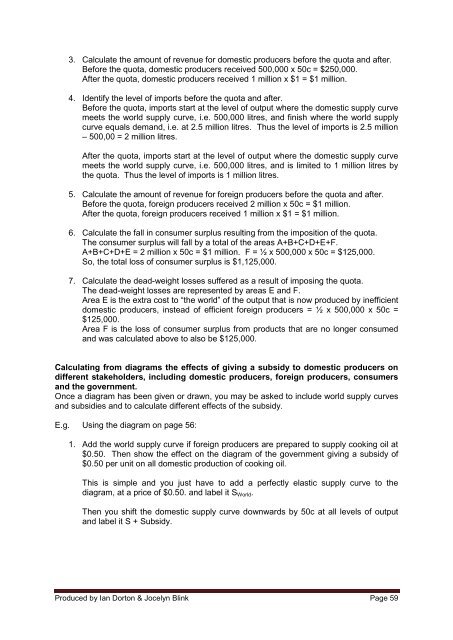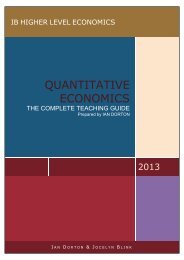QUANTITATIVE ECONOMICS
1l4J48u
1l4J48u
- No tags were found...
You also want an ePaper? Increase the reach of your titles
YUMPU automatically turns print PDFs into web optimized ePapers that Google loves.
3. Calculate the amount of revenue for domestic producers before the quota and after.<br />
Before the quota, domestic producers received 500,000 x 50c = $250,000.<br />
After the quota, domestic producers received 1 million x $1 = $1 million.<br />
4. Identify the level of imports before the quota and after.<br />
Before the quota, imports start at the level of output where the domestic supply curve<br />
meets the world supply curve, i.e. 500,000 litres, and finish where the world supply<br />
curve equals demand, i.e. at 2.5 million litres. Thus the level of imports is 2.5 million<br />
– 500,00 = 2 million litres.<br />
After the quota, imports start at the level of output where the domestic supply curve<br />
meets the world supply curve, i.e. 500,000 litres, and is limited to 1 million litres by<br />
the quota. Thus the level of imports is 1 million litres.<br />
5. Calculate the amount of revenue for foreign producers before the quota and after.<br />
Before the quota, foreign producers received 2 million x 50c = $1 million.<br />
After the quota, foreign producers received 1 million x $1 = $1 million.<br />
6. Calculate the fall in consumer surplus resulting from the imposition of the quota.<br />
The consumer surplus will fall by a total of the areas A+B+C+D+E+F.<br />
A+B+C+D+E = 2 million x 50c = $1 million. F = ½ x 500,000 x 50c = $125,000.<br />
So, the total loss of consumer surplus is $1,125,000.<br />
7. Calculate the dead-weight losses suffered as a result of imposing the quota.<br />
The dead-weight losses are represented by areas E and F.<br />
Area E is the extra cost to “the world” of the output that is now produced by inefficient<br />
domestic producers, instead of efficient foreign producers = ½ x 500,000 x 50c =<br />
$125,000.<br />
Area F is the loss of consumer surplus from products that are no longer consumed<br />
and was calculated above to also be $125,000.<br />
Calculating from diagrams the effects of giving a subsidy to domestic producers on<br />
different stakeholders, including domestic producers, foreign producers, consumers<br />
and the government.<br />
Once a diagram has been given or drawn, you may be asked to include world supply curves<br />
and subsidies and to calculate different effects of the subsidy.<br />
E.g. Using the diagram on page 56:<br />
1. Add the world supply curve if foreign producers are prepared to supply cooking oil at<br />
$0.50. Then show the effect on the diagram of the government giving a subsidy of<br />
$0.50 per unit on all domestic production of cooking oil.<br />
This is simple and you just have to add a perfectly elastic supply curve to the<br />
diagram, at a price of $0.50. and label it S World .<br />
Then you shift the domestic supply curve downwards by 50c at all levels of output<br />
and label it S + Subsidy.<br />
Produced by Ian Dorton & Jocelyn Blink Page 59



